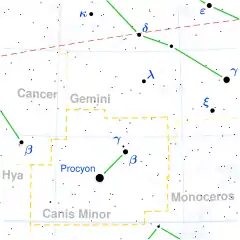Eta Canis Minoris
Eta Canis Minoris (η CMi, η Canis Minoris) is a binary star[3] system in the equatorial constellation of Canis Minor. It is approximately 318 light-years from Earth.
 | |
| Observation data Epoch J2000.0 Equinox J2000.0 (ICRS) | |
|---|---|
| Constellation | Canis Minor |
| Right ascension | 07h 28m 02.07527s[1] |
| Declination | +06° 56′ 31.0897″[1] |
| Apparent magnitude (V) | 5.25[2] + 11.1[3] |
| Characteristics | |
| Spectral type | F0 III[3] |
| U−B color index | +0.17[2] |
| B−V color index | +0.22[2] |
| Astrometry | |
| Radial velocity (Rv) | +17.2[4] km/s |
| Proper motion (μ) | RA: −2.955 ± 0.231[5] mas/yr Dec.: −43.624 ± 0.197[5] mas/yr |
| Parallax (π) | 10.2691 ± 0.1452[5] mas |
| Distance | 318 ± 4 ly (97 ± 1 pc) |
| Absolute magnitude (MV) | 0.1[6] |
| Details | |
| η CMi A | |
| Mass | 2.16[4] M☉ |
| Luminosity | 57.5[4] L☉ |
| Surface gravity (log g) | 3.66[7] cgs |
| Temperature | 7,505±66[4] K |
| Rotational velocity (v sin i) | 54[8] km/s |
| Age | 818[7] Myr |
| Other designations | |
| Database references | |
| SIMBAD | data |
The primary component, η Canis Minoris A, is a yellow-white F-type giant with an apparent magnitude of +5.24. Its companion, η Canis Minoris B, is an eleventh-magnitude star located 4 arcseconds from the primary, though is actually around 440 AU from the main star and takes around 5,000 years to orbit it.[10]
References
- van Leeuwen, F. (2007), "Validation of the new Hipparcos reduction", Astronomy and Astrophysics, 474 (2): 653–664, arXiv:0708.1752, Bibcode:2007A&A...474..653V, doi:10.1051/0004-6361:20078357.
- Johnson, H. L.; et al. (1966), "UBVRIJKL photometry of the bright stars", Communications of the Lunar and Planetary Laboratory, 4 (99), Bibcode:1966CoLPL...4...99J.
- Eggleton, P. P.; Tokovinin, A. A. (September 2008), "A catalogue of multiplicity among bright stellar systems", Monthly Notices of the Royal Astronomical Society, 389 (2): 869–879, arXiv:0806.2878, Bibcode:2008MNRAS.389..869E, doi:10.1111/j.1365-2966.2008.13596.x.
- Luck, R. Earle (September 2015), "Abundances in the Local Region. I. G and K Giants", The Astronomical Journal, 150 (3): 23, arXiv:1507.01466, Bibcode:2015AJ....150...88L, doi:10.1088/0004-6256/150/3/88, 88.
- Brown, A. G. A.; et al. (Gaia collaboration) (August 2018). "Gaia Data Release 2: Summary of the contents and survey properties". Astronomy & Astrophysics. 616. A1. arXiv:1804.09365. Bibcode:2018A&A...616A...1G. doi:10.1051/0004-6361/201833051. Gaia DR2 record for this source at VizieR.
- Jaschek, C.; Gomez, A. E. (1998), "The absolute magnitude of the early type MK standards from HIPPARCOS parallaxes", Astronomy and Astrophysics, 330 (619–625), Bibcode:1998A&A...330..619J.
- David, Trevor J.; Hillenbrand, Lynne A. (2015), "The Ages of Early-Type Stars: Strömgren Photometric Methods Calibrated, Validated, Tested, and Applied to Hosts and Prospective Hosts of Directly Imaged Exoplanets", The Astrophysical Journal, 804 (2): 146, arXiv:1501.03154, Bibcode:2015ApJ...804..146D, doi:10.1088/0004-637X/804/2/146.
- Royer, F.; et al. (October 2002), "Rotational velocities of A-type stars in the northern hemisphere. II. Measurement of v sin i", Astronomy and Astrophysics, 393: 897–911, arXiv:astro-ph/0205255, Bibcode:2002A&A...393..897R, doi:10.1051/0004-6361:20020943.
- "eta CMi". SIMBAD. Centre de données astronomiques de Strasbourg. Retrieved 2017-08-31.
- Kaler, Jim, "Eta and Delta-1 CMi", Stars, University of Illinois, retrieved 2017-09-01.
This article is issued from Wikipedia. The text is licensed under Creative Commons - Attribution - Sharealike. Additional terms may apply for the media files.